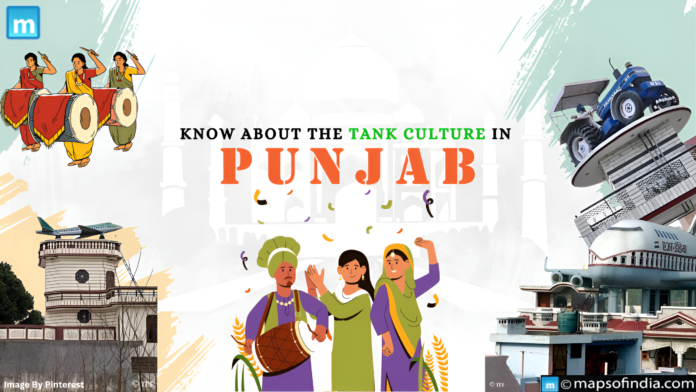A unique cultural phenomenon thrives in the sun-baked plains of Punjab, India: individual water tanks. These tanks, which rise over rooftops like brightly painted sentinels, serve a role other than holding water. They serve as blank canvases for artistic expression, cultural tales, and family legacies, illustrating the experiences of those who call them home.
Origin of The Tank Culture
This vibrant tradition can be traced back hundreds of years. Punjab has struggled with water scarcity due to its arid climate and unstable monsoon rains. Because of this reliance on water for sustenance, extensive irrigation systems and water storage techniques were developed. Large communal tanks, known as “Baolis,” were built to symbolize community resilience and cooperation. Smaller, private tanks began to be built within residences over time. These “Tankis”, known in Punjabi, progressed from simple storage structures to beautiful structures covered with complex designs, religious symbols, and family photographs. Local artists, known as “rangars,” transformed ordinary tanks into works of art using brilliant colors and traditional themes such as flower patterns, paisley designs, and geometric shapes.
Meaning Behind The Tankis
Each tanki has a unique story to tell. A bullock cart traversing a landscape could represent a family’s migration from another village. A cradle image could be used to commemorate a child’s birth. Religious scripture verses engraved on the walls may reflect the family’s religion and ideals. Names of family members, wedding or birth dates, and even blessings are painted on the tanks, giving them a feeling of history and belonging. These unique remarks allow families to leave a lasting legacy that can be carried down through generations.
These customized tanks became a method for families to communicate their personality, history, and future goals. Tank culture is profoundly ingrained in Punjab’s social fabric, not merely aesthetics. These tanks often serve as gathering spots for families and neighbors, providing an opportunity to share stories, celebrate festivals, and establish community relationships. Tankis are decked with flowers and lights during festivals such as Lohri and Baisakhi to contribute to the joyful atmosphere.
Challenges of the Culture
This cultural heritage, however, is experiencing challenges. Individual tanks are becoming less necessary as piped water becomes more widely available. Many families are replacing traditional tanks with modern water storage systems, losing touch with this one-of-a-kind art form and the stories it represents. Efforts are being made to preserve this thriving tradition. Local artists are cooperating with communities to arrange tanki painting workshops and festivals, resurrecting the art form. Organizations record existing tankis and their tales to preserve their heritage for future generations.
The tank culture in Punjab exemplifies the resilient human spirit. It is a narrative about perseverance, creativity, and community. By conserving this one-of-a-kind tradition, we safeguard a beautiful art form and the cultural history of a lively community. So, the next time you see a vividly painted tanki towering above a Punjabi rooftop, remember that it’s more than simply a water storage unit; it’s a canvas for stories, a sign of community, and a monument to the Punjabi people’s enduring spirit.




